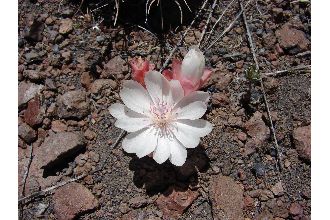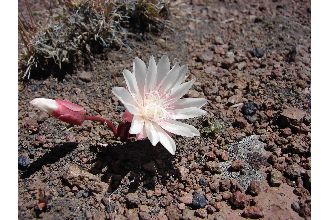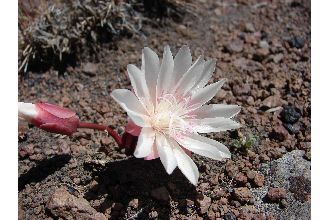Bitter Root
Scientific Name: Lewisia rediviva Pursh

| General Information | |
|---|---|
| Usda Symbol | LERE7 |
| Group | Dicot |
| Life Cycle | Perennial |
| Growth Habits | Forb/herb |
| Native Locations | LERE7 |
Plant Guide
Uses
Ethnobotanic: The roots were harvested with a digging stick and eaten traditionally by the Washoe, Owens Valley Paiute, Northern Paiute, Western Shoshone, Gosiute, Northern Shoshone, Eastern Shoshone, Utah Southern Paiute, Northern Ute, and Flathead. The roots were also an important food for the interior peoples of British Columbia, including the Upper Nlaka'pamux, southern Shuswap, Okanagan-Colville, and southern Kootenay. Lower Nlaka'pamux, Lillooet, northern Shuswap and northern Kootenay peoples obtained them through trade. Families in some cultural groups still gather the roots today. The roots are prepared for eating by removing the bark and boiling, steaming, or pit-roasting them and they are eaten fresh or dried. Because digging the roots destroys the entire plant, care should be taken to propagate and harvest the plants in ways to maintain populations. Wildlife: The gray-crowned rosy finch (Leucosticte tephrocotis) feeds on the seeds of Lewisia spp.
Status
Please consult the PLANTS Web site and your State Department of Natural Resources for this plant’s current status and wetland indicator values.
Description
General: Purslane Family (Portulacaceae). The handsome, flowers range from white to pink with 10-19 petals and multiple stamens (40-47) and 6-8 sepals. The petals are 2-2.5 cm. long. Each plant has many stems, 1-3 cm. long, each with a solitary flower. The flowers are up to 4 cm across and they close at night and reopen with the morning sun. The inflorescence disjoints readily at the middle of the stem on drying. The caudex is short. The seed vessel is an ellipsoid capsule, 5-6 mm. long that encloses dark, shiny seeds. The roots are fleshy and radiating. The many succulent, linear leaves form a rosette and usually wither by flowering time. Alfred Brousseau © St. Mary’sCollege @ CalPhoto
Distribution
For current distribution, please consult the Plant Profile page for this species on the PLANTS Web site. This perennial herbaceous plant is found at a wide elevational range from 60 to 3000 m. It grows in open woodlands and sagebrush shrublands with pine, oak or juniper in many soil types such as shale, sand, clay, granite, serpentine, or talus. It is found in the San Jacinto Mountains and the Transverse Ranges in southern California, the Coast Ranges of California from Mt. Pinos to Mt. Diablo and Lake County, the Klamath Mountains, in the eastern Cascade Ranges of Oregon and Washington, north to British Columbia and east to Montana, Colorado and Arizona.
Establishment
This is a difficult plant to grow, Use soil moisture sensors to measure the soil moisture of Bitter Root., This plant should not be started from the roots, as digging them in the wilds kills the plant, Start the plant from seed in early October, After collecting or buying the seeds, place them in a paper bag until planting time, Place the seed on top of the soil in 4 to 6-inch pots, Sprinkle a light layer of soil over the seeds and place one-quarter inch gravel on top of the soil to hold the seeds in place, Give the pots no water, Let the rains water the pots, Place the containers outside in full sun and protect them from wildlife, The seeds will germinate in late winter or early spring, In May when the leaves turn yellow, stop watering and put the pots in the hottest spot you have until fall when the rains come, Bitter root requires hot, dry summer baking, Repeat this cycle over two years, During the summer or fall of the third year, when the plants are dormant, out-plant the plants in full sun and in well-drained soil, Crown the plants at the soil surface, Plant each plant 4-6 inches apart, Mark the spot where you plant bitter root and give the plants no water, Let the rains come, Protect the plants from deer and other wildlife,
Management
Weed periodically around the plants, as they need full sun. Cultivars, Improved and Selected Materials (and area of origin) LERE7 is available at selected native plant nurseries within its range. Contact your local Natural Resources Conservation Service (formerly Soil Conservation Service) office for more information. Look in the phone book under ”United States Government.” The Natural Resources
Conservation
Service will be listed under the subheading “Department of Agriculture.”


